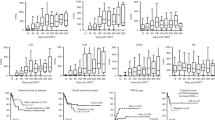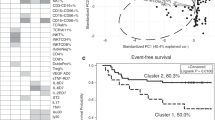Abstract
The success of allogeneic hematopoietic stem cell transplantation (alloSCT) is indicated by the reconstitution of the peripheral blood system of patients after alloSCT and the engraftment of hematopoietic stem and progenitor cells (HSPCs) into their bone marrow (BM). The number of CD34+ cells is commonly used as surrogate for the content of hematopoietic stem cells in the grafts. During the last decade, several antigens (including CD133, CD45RA, CD38, and CD10) were identified allowing discrimination of different HSPC subpopulations within the human CD34+ cell compartment. Although such studies increased our understanding of early human hematopoiesis tremendously, hardly any study dissected the CD34+ compartment in the alloSCT setting. Consequently, we comprehensively analyzed the CD34+ compartment in G-CSF-stimulated peripheral blood stem cell grafts of allogeneic donors, in BM samples of the respective recipients 4 weeks after alloSCT, and in BM samples of healthy donors. We demonstrate that alloSCT is associated with a dramatic shift from primitive to more mature HSPC types. Upon investigating whether the composition of engrafted CD34+ cells has any impact on the incidence and severity of graft-versus-host disease, we did not find any correlation. However, more detailed analyses of the CD34+ compartment may elucidate associations with other transplantation-related complications.
This is a preview of subscription content, access via your institution
Access options
Subscribe to this journal
Receive 12 print issues and online access
$259.00 per year
only $21.58 per issue
Buy this article
- Purchase on Springer Link
- Instant access to full article PDF
Prices may be subject to local taxes which are calculated during checkout






Similar content being viewed by others
References
Gratama JW, Orfao A, Barnett D, Brando B, Huber A, Janossy G. et al. Flow cytometric enumeration of CD34+ hematopoietic stem and progenitor cells. European Working Group on Clinical Cell Analysis. Cytometry. 1998;34:128–42.
Kamel AM, El-Sharkawy N, Mahmoud HK, Khalaf MR, El Haddad A, Fahmy O. et al. Impact of CD34 subsets on engraftment kinetics in allogeneic peripheral blood stem cell transplantation. Bone Marrow Transpl. 2005;35: 129–36. https://doi.org/10.1038/sj.bmt.1704755.
Manz MG, Miyamoto T, Akashi K, Weissman IL. Prospective isolation of human clonogenic common myeloid progenitors. Proc Natl Acad Sci USA. 2002;99:11872–7.
Reya T, Morrison SJ, Clarke MF, Weissman IL. Stem cells, cancer, and cancer stem cells. Nature. 2001;414:105–11. https://doi.org/10.1038/35102167
Giebel B, Zhang T, Beckmann J, Spanholtz J, Wernet P, Ho AD, et al. Primitive human hematopoietic cells give rise to differentially specified daughter cells upon their initial cell division. Blood. 2006;107:2146–52. https://doi.org/10.1182/blood-2005-08-3139
Adolfsson J, Mansson R, Buza-Vidas N, Hultquist A, Liuba K, Jensen CT, et al. Identification of Flt3+ lympho-myeloid stem cells lacking erythro-megakaryocytic potential a revised road map for adult blood lineage commitment. Cell. 2005;121:295–306. https://doi.org/10.1016/j.cell.2005.02.013
Giebel B, Punzel M. Lineage development of hematopoietic stem and progenitor cells. Biol Chem. 2008;389:813–24. https://doi.org/10.1515/BC.2008.092
Görgens A, Radtke S, Mollmann M, Cross M, Durig J, Horn PA, et al. Revision of the human hematopoietic tree: granulocyte subtypes derive from distinct hematopoietic lineages. Cell Rep. 2013;3:1539–52. https://doi.org/10.1016/j.celrep.2013.04.025
Beckmann J, Scheitza S, Wernet P, Fischer JC, Giebel B. Asymmetric cell division within the human hematopoietic stem and progenitor cell compartment: identification of asymmetrically segregating proteins. Blood. 2007;109:5494–501. https://doi.org/10.1182/blood-2006-11-055921
Görgens A, Ludwig AK, Möllmann M, Krawczyk A, Dürig J, Hanenberg H, et al. Multipotent hematopoietic progenitors divide asymmetrically to create progenitors of the Lympho-Myeloid and Erythro-Myeloid Lineages. Stem Cell Rep. 2015;5:154–5.
Radtke S, Gorgens A, Kordelas L, Schmidt M, Kimmig KR, Koninger A, et al. CD133 allows elaborated discrimination and quantification of haematopoietic progenitor subsets in human haematopoietic stem cell transplants. Br J Haematol. 2015;169:868–78. https://doi.org/10.1111/bjh.13362
Doulatov S, Notta F, Eppert K, Nguyen LT, Ohashi PS, Dick JE. Revised map of the human progenitor hierarchy shows the origin of macrophages and dendritic cells in early lymphoid development. Nat Immunol. 2010;11:585–93.
Gorgens A, Radtke S, Horn PA, Giebel B. New relationships of human hematopoietic lineages facilitate detection of multipotent hematopoietic stem and progenitor cells. Cell Cycle. 2013;12:3478–82. https://doi.org/10.4161/cc.26900
Drissen R, Buza-Vidas N, Woll P, Thongjuea S, Gambardella A, Giustacchini A, et al. Distinct myeloid progenitor-differentiation pathways identified through single-cell RNA sequencing. Nat Immunol. 2016;17:666–76. https://doi.org/10.1038/ni.3412
Velten L, Haas SF, Raffel S, Blaszkiewicz S, Islam S, Hennig BP, et al. Human haematopoietic stem cell lineage commitment is a continuous process. Nat Cell Biol. 2017;19:271–81. https://doi.org/10.1038/ncb3493
Filipovich AH, Weisdorf D, Pavletic S, Socie G, Wingard JR, Lee SJ, et al. National Institutes of Health consensus development project on criteria for clinical trials in chronic graft-versus-host disease: I. Diagnosis and staging working group report. Biol Blood Marrow Transpl. 2005;11:945–56. https://doi.org/10.1016/j.bbmt.2005.09.004
Glucksberg H, Storb R, Fefer A, Buckner CD, Neiman PE, Clift RA. et al. Clinical manifestations of graft-versus-host disease in human recipients of marrow from HL-A-matched sibling donors. Transplantation. 1974;18:295–304.
Przepiorka D, Weisdorf D, Martin P, Klingemann HG, Beatty P, Hows J. 1994 consensus conference on acute GVHD grading. Bone Marrow Transplant. 1995;15:825–8.
Amariglio N, Jacob-Hirsch J, Shimoni A, Leiba M, Rechavi G, Nagler A. Changes in gene expression pattern following granulocyte colony-stimulating factor administration to normal stem cell sibling donors. Acta Haematol. 2007;117:68–73. https://doi.org/10.1159/000096856
Dmytrus J, Matthes-Martin S, Pichler H, Worel N, Geyeregger R, Frank N, et al. Multi-color immune-phenotyping of CD34 subsets reveals unexpected differences between various stem cell sources. Bone Marrow Transpl. 2016;51:1093–1100. https://doi.org/10.1038/bmt.2016.88
Podesta M, Piaggio G, Frassoni F, Pitto A, Mordini N, Bregante S, et al. Deficient reconstitution of early progenitors after allogeneic bone marrow transplantation. Bone Marrow Transpl. 1997;19:1011–7. https://doi.org/10.1038/sj.bmt.1700785
Selleri C, Maciejewski JP, De Rosa G, Raiola A, Risitano AM, Picardi M, et al. Long-lasting decrease of marrow and circulating long-term culture initiating cells after allogeneic bone marrow transplant. Bone Marrow Transpl. 1999;23:1029–37. https://doi.org/10.1038/sj.bmt.1701759
Woolthuis CM, Brouwers-Vos AZ, Huls G, de Wolf JT, Schuringa JJ, Vellenga E. Loss of quiescence and impaired function of CD34(+)/CD38(low) cells one year following autologous stem cell transplantation. Haematologica. 2013;98:1964–71. https://doi.org/10.3324/haematol.2013.086744
Yahata T, Takanashi T, Muguruma Y, Ibrahim AA, Matsuzawa H, Uno T, et al. Accumulation of oxidative DNA damage restricts the self-renewal capacity of human hematopoietic stem cells. Blood. 2011;118:2941–50. https://doi.org/10.1182/blood-2011-01-330050
Radtke S, Gorgens A, Liu B, Horn PA, Giebel B. Human mesenchymal and murine stromal cells support human lympho-myeloid progenitor expansion but not maintenance of multipotent haematopoietic stem and progenitor cells. Cell Cycle. 2016;15:540–5. https://doi.org/10.1080/15384101.2015.1128591
Milner LA, Bigas A. Notch as a mediator of cell fate determination in hematopoiesis: evidence and speculation. Blood. 1999;93:2431–48.
Yamamoto R, Morita Y, Ooehara J, Hamanaka S, Onodera M, Rudolph KL, et al. Clonal analysis unveils self-renewing lineage-restricted progenitors generated directly from hematopoietic stem cells. Cell. 2013;154:1112–26. https://doi.org/10.1016/j.cell.2013.08.007
Notta F, Zandi S, Takayama N, Dobson S, Gan OI, Wilson G, et al. Distinct routes of lineage development reshape the human blood hierarchy across ontogeny. Science. 2016;351:aab2116. https://doi.org/10.1126/science.aab2116
Acknowledgements
We are grateful to Iina Fischer from the Deutsches Rotes Kreuz for providing bone marrow samples of five Westdeutsche SpenderZentrale (WSZE) donors as healthy controls and to Martina Franke for performing the flow cytometry analyses. André Görgens is an International Society for Advancement of Cytometry (ISAC) Marylou Ingram Scholar (2019–2023).
Author information
Authors and Affiliations
Corresponding authors
Ethics declarations
Conflict of interest
The authors declare that they have no conflict of interest.
Additional information
Publisher’s note: Springer Nature remains neutral with regard to jurisdictional claims in published maps and institutional affiliations.
Supplementary information
Rights and permissions
About this article
Cite this article
Kordelas, L., Görgens, A., Radtke, S. et al. Allogeneic transplantation of peripheral blood stem cell grafts results in a massive decrease of primitive hematopoietic progenitor frequencies in reconstituted bone marrows. Bone Marrow Transplant 55, 100–109 (2020). https://doi.org/10.1038/s41409-019-0645-7
Received:
Revised:
Accepted:
Published:
Issue Date:
DOI: https://doi.org/10.1038/s41409-019-0645-7



